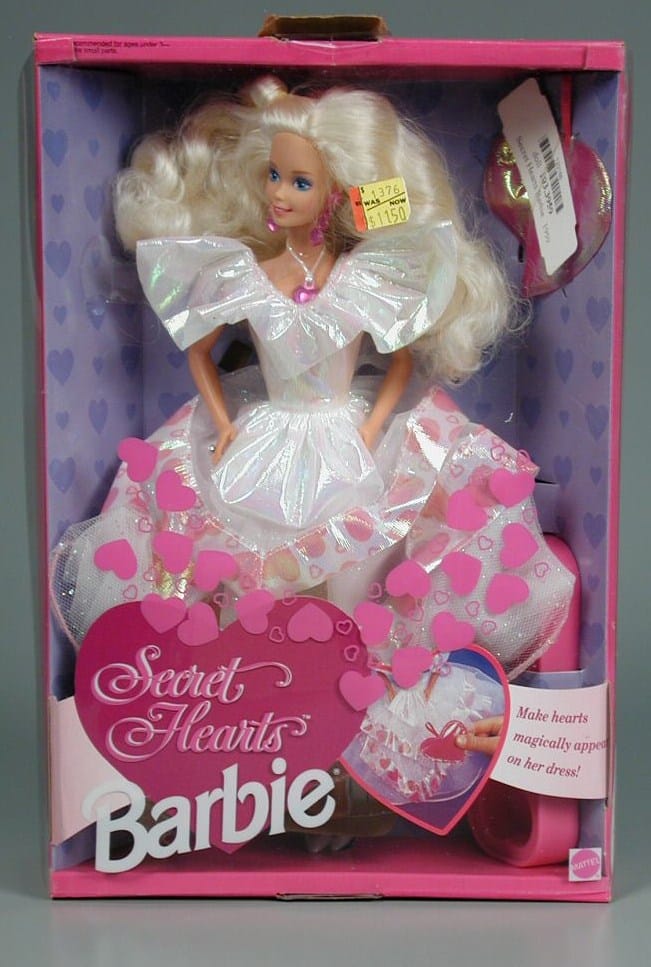 If you believe, as I did, that Barbie has a flair for fashion unparalleled among dolls, what with her sparkling, sequined, and infinite polyester outfits, then you’re in for a bit of a shock. Barbie may hold the title of princess in the world of style but, with a wardrobe that would make even the most glamorous Barbie gawk, the French fashion doll of the mid-19th century reigns as undisputed queen.
If you believe, as I did, that Barbie has a flair for fashion unparalleled among dolls, what with her sparkling, sequined, and infinite polyester outfits, then you’re in for a bit of a shock. Barbie may hold the title of princess in the world of style but, with a wardrobe that would make even the most glamorous Barbie gawk, the French fashion doll of the mid-19th century reigns as undisputed queen.
French fashion dolls have their roots in the clothing industry. As early as the 17th century, French fashion houses outfitted miniature mannequins in the latest Parisian couture and sent them all over Europe to promote the current styles. In the 19th century, when illustrated journals replaced these little fashion emissaries, a doll-making industry emerged in Paris, essentially repurposing the mannequins as playthings for young girls.
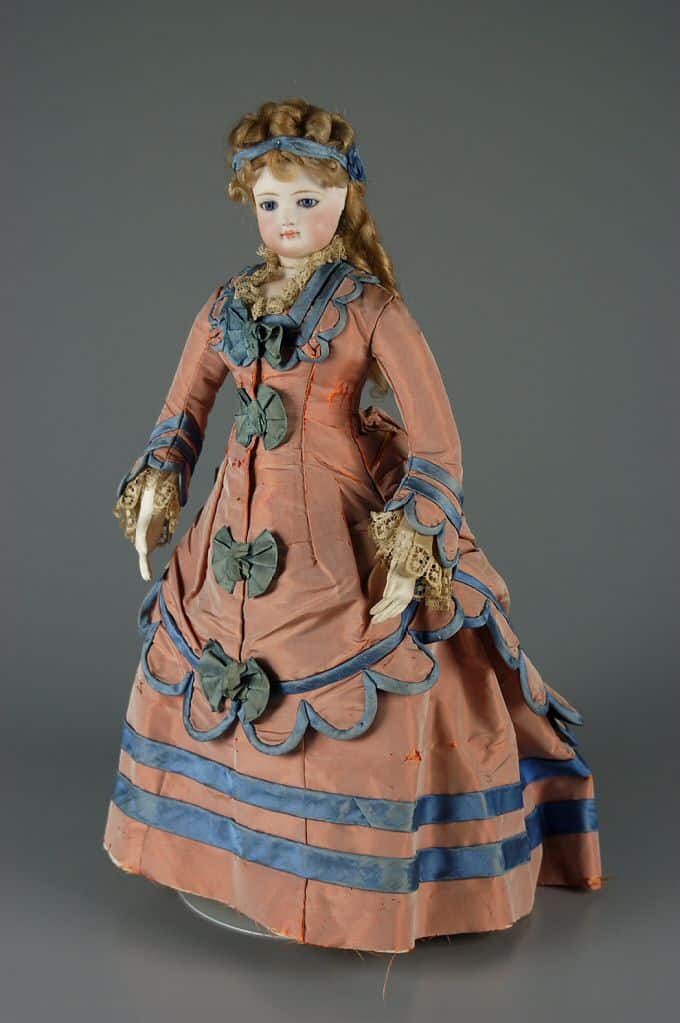 During their 30-year heyday, from 1850 to 1880, fashion doll production flourished. Dolls came in all shapes and sizes. They had delicate bisque or porcelain faces, painted and molded with care, and often featured stunning glass eyes. Dolls wore mohair or human hair wigs styled in intricate ringlets or braids.
During their 30-year heyday, from 1850 to 1880, fashion doll production flourished. Dolls came in all shapes and sizes. They had delicate bisque or porcelain faces, painted and molded with care, and often featured stunning glass eyes. Dolls wore mohair or human hair wigs styled in intricate ringlets or braids.
Perhaps most importantly, the dolls had jointed bodies, enabling children to undress and redress the dolls with ease. Therefore, the dolls could stay true to their haute couture heritage. Manufacturers also profited from the wardrobes and trousseaus that accompanied the dolls, brimming with elaborate dresses and gowns for every occasion, as well as robes, coats, and a plethora of accessories: kid gloves, hats, parasols, purses, jewelry, and even opera glasses.
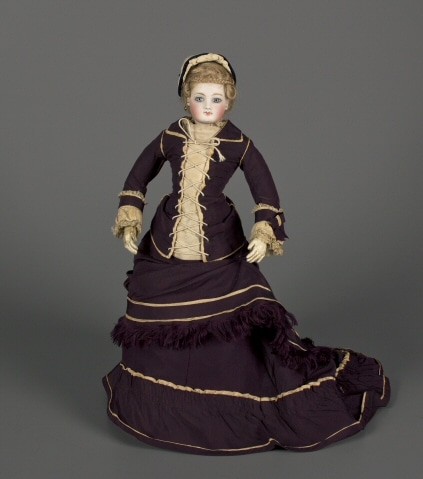 Made of the finest silks and brocades, and decorated with delicate lace, ruffles, and pleats, these fashion doll costumes mimicked the lavish gowns that Victorian women wore as a reflection of their social status and femininity. In an era ruled by etiquette and strict social guidelines, these dolls modeled perfectly the ideal female: immaculately coiffed, elegantly attired, docile, and silent. Fashion dolls taught girls to be fashionable, well-behaved young women, and kept girls politely occupied in the home.
Made of the finest silks and brocades, and decorated with delicate lace, ruffles, and pleats, these fashion doll costumes mimicked the lavish gowns that Victorian women wore as a reflection of their social status and femininity. In an era ruled by etiquette and strict social guidelines, these dolls modeled perfectly the ideal female: immaculately coiffed, elegantly attired, docile, and silent. Fashion dolls taught girls to be fashionable, well-behaved young women, and kept girls politely occupied in the home.
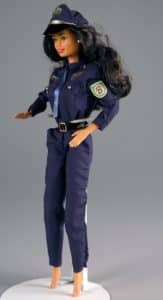 Barbie and the French fashion doll have in common this rather controversial portrayal of women. Both value flawless, ageless (and ultimately unobtainable) beauty, and depict women as, above all else, consumers. Barbie has been criticized for her shallow and objectified interpretation of women, and in response to this criticism, Barbie became more than just a fashionista. Suddenly, she was an astronaut, race car driver, police officer, and doctor. Today, Barbie has limitless options (though I would like to point out that whether she is joining the Navy or saving lives in the ER, she always does it in heels). French fashion dolls did not have the same options, nor did the girls who owned and played with them. The dolls’ wardrobes, though extensive, varied little compared to Barbie’s, including evening gowns, day dresses, and perhaps a wedding gown, confining the dolls, and likely girls’ imaginations, to socially acceptable roles. During the Victorian Era, with the women’s rights movement only in its infancy, women did not yet have the right to vote in America, and society viewed women narrowly, as wives and mothers, and little more. French fashion dolls give us a glimpse into the constricted lives of a 19th-century woman.
Barbie and the French fashion doll have in common this rather controversial portrayal of women. Both value flawless, ageless (and ultimately unobtainable) beauty, and depict women as, above all else, consumers. Barbie has been criticized for her shallow and objectified interpretation of women, and in response to this criticism, Barbie became more than just a fashionista. Suddenly, she was an astronaut, race car driver, police officer, and doctor. Today, Barbie has limitless options (though I would like to point out that whether she is joining the Navy or saving lives in the ER, she always does it in heels). French fashion dolls did not have the same options, nor did the girls who owned and played with them. The dolls’ wardrobes, though extensive, varied little compared to Barbie’s, including evening gowns, day dresses, and perhaps a wedding gown, confining the dolls, and likely girls’ imaginations, to socially acceptable roles. During the Victorian Era, with the women’s rights movement only in its infancy, women did not yet have the right to vote in America, and society viewed women narrowly, as wives and mothers, and little more. French fashion dolls give us a glimpse into the constricted lives of a 19th-century woman.
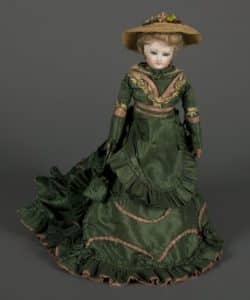 The Strong’s collection features Barbie prominently, and rightfully so. But the next time you see examples of these dolls (currently in cases 30 through 34) on the museum’s second floor or peruse the online collections, pay some attention to Barbie’s predecessors, and not only because their fabulous costumes challenge even Barbie’s fashion prowess, but also because they provide a great deal of historical insight into a world that was, for women, as cinched, ruffled, and confining as the gowns they wore.
The Strong’s collection features Barbie prominently, and rightfully so. But the next time you see examples of these dolls (currently in cases 30 through 34) on the museum’s second floor or peruse the online collections, pay some attention to Barbie’s predecessors, and not only because their fabulous costumes challenge even Barbie’s fashion prowess, but also because they provide a great deal of historical insight into a world that was, for women, as cinched, ruffled, and confining as the gowns they wore.



